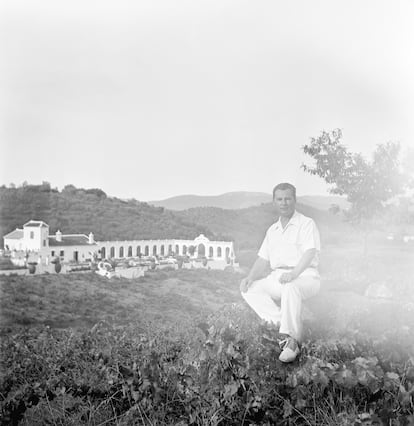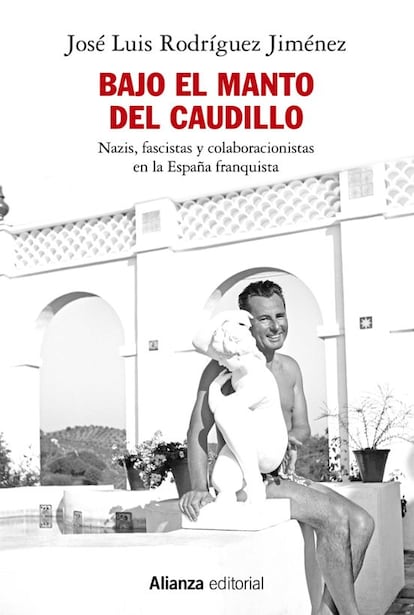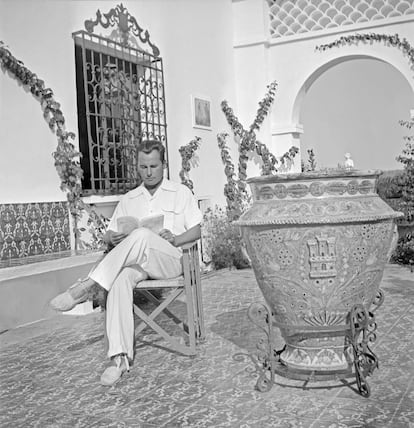Spain, a Nazi hideout
The book ‘Bajo el manto del Caudillo’ depicts Franco’s Spain as the European country where the most high-ranking officials and collaborators of the Third Reich were in hiding


Paris had already been liberated. The fall of Berlin seemed imminent. The world war was over and hundreds of Nazis found refuge in Spain: a kindred country, with a brotherly regime. Not only did grassroots Nazis arrive, but also high-ranking officials from the Third Reich, from Mussolini’s Italy, from other fascist regimes such as the Independent State of Croatia and collaborators from Vichy France. Those defeated crossed the Pyrenees on foot or by car, and they also came in small boats or airplanes. They then secretly remained in hiding in the Spain of the 1940s.
They were protected by the Franco regime. Under false names. Housed in the spas of Sobrón (Álava), Urberuaga de Ubilla and Molinar de Carranza (Biscay), Jaraba (Zaragoza) and Caldas de Malavella (Girona). Lodged in the Palace hotel (Madrid), in houses in El Viso (also in the capital) and in Marbella (Malaga), they sought to avoid deportation. They evaded foreign spies who came to capture them or even to bump them off. This is how they are portrayed in Bajo el manto del Caudillo (Under the Caudillo’s mantle), a book written by historian José Luis Rodríguez Jiménez after decades of study and which constitutes the most extensive research done to date on a secret subject purged from Spanish archives.
One case is that of Reinhard Spitzy. German SS Captain. Military spy of the Nazi Abwehr (intelligence service). He knew he was wanted in Spain and hid well, taking shelter in a sacred place. He stayed in the priest’s house in Oreña (Cantabria), then in the collegiate church of Santillana del Mar where he lived as a monk, and eventually he became known as “Brother Ricardo of Ireland” in the Burgos monastery of San Pedro de Cardeña, in Castrillo del Val, where he spent more than a year. The author says that to be able to accomplish his escape plan to Argentina, Spitzy sold the blueprints for the construction of an anti-aircraft rocket to the Spanish Army through the Falangist general Juan Yagüe. As a result, he received protection and false Spanish documentation for himself and his family, and in 1948 they departed for Argentina, the great haven of Nazi peace in South America.

Another case had a very distinct ending. It was June 1945. French policemen under false identities entered Spain in search of Michel Szkolnikov, who lived in the Madrid colony of El Viso with his Berlin partner, Elfriede Tietz, also known as Hélène Samson. Both had been profiting in occupied France by dealing on the black market for the Germans. The plan was to capture him, take him to France and interrogate him there. But the agents of democratic France went too far. “Szkolnikov died in the car, only 30 kilometers from the capital, as a result of a beating to subdue him. The French agents decided to burn the corpse and disappear, but were arrested shortly after by the Spanish police,” says the author, professor of Contemporary History at the Universidad Rey Juan Carlos.
The book is a journey into these secret lives shaped by the defeat of Nazism and Fascism in Europe and the individual fear of trials and possible executions. The hunters being hunted down. It is also a glimpse of an uncomfortable reality for the Franco regime. First, because the Allies knew that Spain had become the European country that welcomed the largest number of Nazis, fascists, ultra-right-wingers and collaborators with the Third Reich since the second half of 1944. And their presence was a cause of tension with the Allies in the midst of Spain’s international isolation.
However, the arrivals also provided an opportunity for the Franco dictatorship, which helped Nazis and collaborators hiding in Spain. It did not do so only out of ideological sympathy, interests were involved too. As explained to EL PAÍS by the book’s author, two main reasons influenced their protection. First of all, “given their knowledge of the Spanish-German collaboration, it was not convenient for them to be interrogated by Allied officials.” Secondly, these German and French fugitives had performed roles of economic management, espionage and for the political police in the front line and could continue to contribute their experience in these areas. Therefore, they were a recruitable talent for Franco’s Spain and could be potential spies.
One example is that the Defence High Command recruited several German spies who had been active in Spain and the Spanish protectorate in Morocco during World War II. The book traces the shadowy steps of someone who used many names ― such as Wilhelm Friedrich Heinrich Knipa, José Luis Gurruchaga Iturria and Friedrich-Ludwig Von Freienfels ― to investigate members of the Republican exile who worked in peaceful and violent opposition to Franco’s regime.

Rodríguez Jiménez, who completed his doctorate with a thesis dedicated to the Spanish far right from the late Franco era to the consolidation of democracy (1967-1982), highlights one aspect. It was not only a question of quantity, but also of quality. High-ranking Nazis, such as the head of the Vichy French government, the pro-Nazi Pierre Laval, came into Franco’s den. Franco handed him over to the new French authorities, under pressure and to ingratiate himself, and he was subsequently shot. Afterwards, there were no more compliant surrenders ― the lesson had been learned.
His collaborating ministers Abel Bonnard, minister of Education, and Maurice Gabolde, minister of Justice, were also in Spain. Another was Louis Darquier de Pellepoix, an anti-Semitic journalist and ultra politician who headed the Commissariat-General for Jewish Affairs of the Vichy government and collaborated with the Gestapo in the deportation of French Jews to extermination camps. In Spain, he acquired a new identity: Juan Esteve, French teacher at the Army’s Escuela de Estado Mayor and at the Central School of Languages, and translator at the ministry of foreign affairs.
Karl Bömelburg, head of the Gestapo in France, lived undetected in the mountains of Madrid. He had been presumed dead, but he was still in Spain until his friend Ramón Serrano Suñer accompanied him to Madrid’s Barajas airport on his way to Switzerland. Also hiding in Spain was the main Belgian collaborator with the Third Reich, Léon Degrelle, a radical and narcissistic politician with a peculiar life, who serves as the guiding line for this book that traces a series of lives that went from totalitarian hegemony to clandestinity.
This was the case for the head of the Hitler Youth, Bernhard Feuerriegel, who entered Spain in July 1944. He was assisted by the covert network coordinated in Madrid by Clara Stauffer, which helped him obtain a new identity. He became Bernardo Fernández, a man from Tarragona and a mechanical engineer by profession. This is how he settled in Madrid, in the house of a lady he trusted. He fell in love with her daughter and married her. He ended up working as a music teacher in a Spain that was so permissive with the escaped Nazis.
In the case of Josef Hans Lazar, press attaché of the German Embassy in Spain, thanks to his acquaintances he was able to feign an attack of appendicitis that earned him a long stay in the Ruber clinic. According to the author’s hypothesis, he was subsequently taken in at a convent of Irish nuns in Salamanca. Much less discreet was Meino Von Eitzen, a Nazi Abwehr spy and prestigious horseman, who settled in Vigo under the guise of being the manager of the company Depósito Español de Carbones SA and filled his stables with horses.
There was indeed a turbulent political effect, virtually undetectable, among so many Nazis in hiding in post-war Spain. “Degrelle and other Nazis ― explains the author ― were drivers of Holocaust denialist theories in Spain, with the purpose of whitewashing the Nazi past and their own in an attempt to make Nazi ideas more acceptable to the new generations.”
However, in the upper echelons, things did not go beyond that. José Luis Rodríguez Jiménez says that, “the influence of Nazi and Fascist refugees in Spain was non-existent because the Franco regime had been forced to initiate a process of defascistization with the defeat of Hitler and Mussolini.” The last Spanish contingents in the Blue Division were returning from the front. The fascist salute would cease to be official and obligatory a few months later. Spain was reinventing itself and a new fascist regime called Francoism was born.
Sign up for our weekly newsletter to get more English-language news coverage from EL PAÍS USA Edition
Tu suscripción se está usando en otro dispositivo
¿Quieres añadir otro usuario a tu suscripción?
Si continúas leyendo en este dispositivo, no se podrá leer en el otro.
FlechaTu suscripción se está usando en otro dispositivo y solo puedes acceder a EL PAÍS desde un dispositivo a la vez.
Si quieres compartir tu cuenta, cambia tu suscripción a la modalidad Premium, así podrás añadir otro usuario. Cada uno accederá con su propia cuenta de email, lo que os permitirá personalizar vuestra experiencia en EL PAÍS.
En el caso de no saber quién está usando tu cuenta, te recomendamos cambiar tu contraseña aquí.
Si decides continuar compartiendo tu cuenta, este mensaje se mostrará en tu dispositivo y en el de la otra persona que está usando tu cuenta de forma indefinida, afectando a tu experiencia de lectura. Puedes consultar aquí los términos y condiciones de la suscripción digital.








































